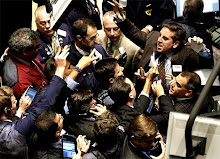WASHINGTON – Federal Reserve officials have a slightly dimmer view of the economy than they did in April, reflecting worries about how the European debt crisis could affect U.S. growth and job prospects.
Fed officials said Wednesday in an updated economic forecast that they think the economy, as measured by the gross domestic product, will grow between 3 percent and 3.5 percent this year. That's a downward revision from a growth range in their April forecast of 3.2 percent to 3.7 percent.
The Fed's latest forecast sees the unemployment rate, now at 9.5 percent, possibly staying at that figure or in the best case falling to 9.2 percent. In the April forecast, the Fed had a slightly lower bottom number of 9.1 percent.
The Fed said in the minutes of its June 22-23 meeting that its lower economic projections reflected "economic developments abroad" — a reference to the debt crisis that began in Greece and threatened to spread to other European countries.
While reducing the forecast for growth and employment, the Fed also saw less of a threat from inflation.
The Fed predicted that a key inflation gauge that's tied to consumer spending would show prices rising 1 percent to 1.1 percent this year. That's down from an April forecast that consumer prices would increase by 1.2 percent to 1.5 percent.
The absence of inflationary pressures gives the Fed leeway to keep interest rates low to try to bolster growth as the economy recovers from the deepest recession since the 1930s.
The new forecast was compiled at the last meeting of the Fed's interest rate-setting Federal Open Market Committee on June 22-23. At that meeting, the FOMC, which is composed of Fed board members and the 12 Fed regional bank presidents, kept a key rate at a record low of 0 to 0.25 percent, where it's been since December 2008.
The Fed's new forecast made only minor changes to its outlook for growth, unemployment and inflation. But those changes underscored a view that economic prospects were slightly weaker.
The factors the Fed cited were household and business uncertainty, weak real estate markets, a tough job market, waning fiscal stimulus and still-tight lending by banks.
The Fed in April had said only a minority of Fed officials thought it would take more than five or six years to reach the Fed's goals for maximum employment with low inflation. But in the new minutes, the Fed changed that to say that "most" expected it to take "no more than five or six years."
Beyond this year, the Fed forecast growth in 2011 to be in a range between 3.5 percent to 4.2 percent. The upper limit of that range was reduced from 4.5 percent in the April forecast.
The expectation for the unemployment rate next year was also nudged higher to a range of 8.3 percent to 8.7 percent. That was up from a range of 8.1 percent to 8.5 percent in April.
To obtain its forecast ranges, the Fed excludes the three highest and three lowest forecasts of Fed officials for each economic variable.
Wednesday, July 14, 2010
Subscribe to:
Comments (Atom)

